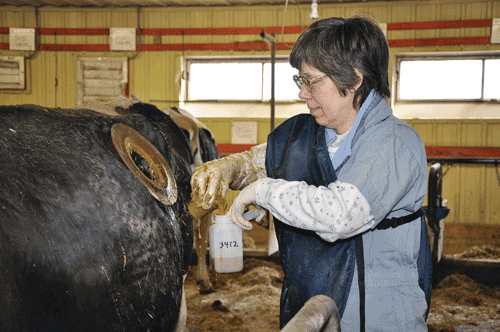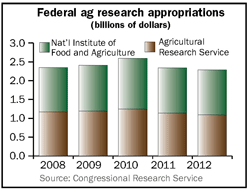
Sampling rumen fluid from fistulated cows is part of the routine at the U.S. Dairy Forage Research Center in Wisconsin. The center has need for a unit for intensive nutrition.
Flat or down pretty much describes the trends in federal and state ag research funding. The situation is a little better for privately funded research.
Federal and state funding for research in plants and natural resources, which includes soils, totaled $2.287 billion in 2010. That was down $169 million from five years earlier.
Federal and state funding for animal-related research was $920.7 million in 2010. In 2005, it had been an even $1 billion.
USDA now has two main research agencies. They are the well-known Agricultural Research Service (ARS) and the new National Institute of Food and Agriculture (NIFA). The graph shows appropriations for these two agencies for the past five fiscal years (FYs).
Dairy-related ARS funding for FY 2012 was $42.2 million, down 7.1 percent from FY 2011. Estimated ARS dairy funding for FY 2013 is $41.45 million.
Largest dairy-related ARS recipient is the Beltsville Agricultural Research Center (BARC) in Maryland with FY 2012 funding of $14 million ($15.2 million in FY 2011). BARC dairy work includes projects on preventing Staph. aureus and E. coli mastitis, controlling Neospora-related abortions, improving feed efficiency and managing nitrogen from dairy farms.
BARC also is home to the high-profile Animal Improvement Programs Laboratory (AIPL). It had FY 12 funding of $2.925 million. AIPL's research is aimed at using production and physical trait data to improve genomic predictions. AIPL also has been the source of our sire and cow genetic evaluations.
The National Animal Disease Center (NADC) at Ames, Iowa, had FY 2012 funding of $12.88 million, which was down 8 percent from FY 2011. Transition-cow health, mastitis, Johne's (new tests and vaccines) and respiratory diseases are its primary dairy projects.
Another ARS facility, the U.S. Dairy Forage Research Center in Wisconsin, had an FY 2012 budget of $3.48 million, unchanged from the year before. That center has among its priorities redesigning alfalfa to improve digestibility, developing new forages for grazing systems and improving utilization of all forages. It has plans for a greatly needed intensive nutrition unit that would research ways to reduce greenhouse gases produced by cows.
Other ARS dairy-related facilities had FY 2012 budgets totaling $11.77 million. Projects address animal welfare, disease control and pest and parasite research. An ARS facility at Wyndmoor, Pa., that had an FY 2012 budget of $5.74 million, conducts dairy foods-related research.
NIFA supports research, education and extension activities through competitive grants and formula funding to land-grant universities and other institutions.
There are scores of dairy-related, NIFA-funded research projects. Major ones relate to E. coli in the beef supply ($9.8 million over five years), the bovine respiratory disease complex ($9.75 million; four years), improving feed efficiency ($9.5 million; five years) and organic dairying ($2.86 million over five years). Other projects address genetic and nutrition aspects of heat stress tolerance, phosphorus management, chronic endometritis, lepto, bovine TB and various aspects of fertility.
Some disease research in the past for all species has been supported by so-called Section 1433 funds first authorized by the Research Act of 1977 and administered by NIFA. The amount per year was not to exceed $25 million, but actual appropriations rarely have been more than $5 million per year, according to Dale Bjorling at the University of Wisconsin School of Veterinary Medicine.
The Johne's Disease Integrated Program (JDIP) was funded at $1.5 million per year between 2006 and 2008. For 2009 through 2012, the support was cut to $1.2 million per year.
NIFA and ARS account for about 90 percent of USDA's research, education and extension mission. Two others, also part of that mission, are the National Agricultural Statistics Service and the Economic Research Service. Some ag research is funded by the Department of Energy and the National Institutes of Health (NIH).
Land-grant universities and other state research sites also are funded by state budgets. In 2010, state appropriations made up 28 percent of all public ag research funding across all disciplines, according to USDA's Current Research Information Service. At $1.19 billion, that funding was down 3.3 percent from 10 years earlier.
USDA funding lags
 While ag research funding has faltered, other research agencies have fared much better. Combined, USDA's two major research agencies, ARS and NIFA, have an annual budget of $2.3 billion. By comparison, NIH has a budget over $31 billion. The National Science Foundation (NSF) has a budget of $7 billion.
While ag research funding has faltered, other research agencies have fared much better. Combined, USDA's two major research agencies, ARS and NIFA, have an annual budget of $2.3 billion. By comparison, NIH has a budget over $31 billion. The National Science Foundation (NSF) has a budget of $7 billion.Between 1983 and 2003, the average annual budget growth rates for NIH and NSF were 5.73 percent and 2.43 percent, respectively. The average annual research and development growth rate for USDA was 0.70 percent, according to the Global Harvest Initiative, a policy center supported by agricultural firms.
Since 1990, private spending for ag research in the U.S. has seen an annual average growth rate of 1.1 percent in terms of real dollars. That essentially is the same growth rate as public research funding.
Over the past 10 years, private research and development spending on crop seed and biotechnology research in the United States doubled from $1.045 billion to $2.176 billion, according to a USDA Economic Research Service publication (ERR 130). Crop chemical funding was nearly flat, going from $703 million to $793 million.
During that same period, privately funded food-animal health research rose from $176 million to $309 million. Animal nutrition research by private companies changed little and remained in the $60-million to $90-million range.
Worldwide, research and development expenditures in 2010 on all ag inputs (plants and animals) by private industry totaled $10.288 billion, according to the ERS publication. Of that, $8.711 billion was for crop-related research, while $1.577 was for food animal-related work.
In constant (inflation-adjusted) dollars, crop-related research has jumped $3.014 billion or 53 percent since 1994. By contrast, expenditures for food-animal research went up only $61 million or just 4 percent during that period.
Of the $1.577 billion spent on animal-related research by private companies worldwide in 2010, the majority ($878 million) was spent on animal health-related investigations. Smaller amounts were spent on animal breeding and genetics ($316 million) and animal nutrition ($383 million).
This article appears on page 567 of the September 10, 2012 issue of Hoard's Dairyman.










